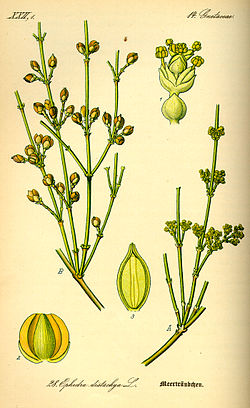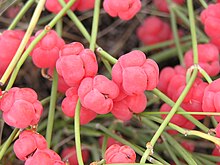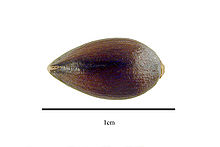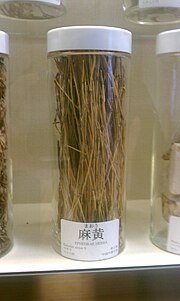| Ephedraceae | |
|---|---|

| |
| Ephedra distachya | |
| Scientific classification | |
| Kingdom: | |
| Division: | |
| Order: | |
| Genus: | Ephedra
|
The ephedraceae (scientific name Ephedraceae ) are a family of gymnosperm gnetales whose only genus, Ephedra, has 60 species. [1] The species are mostly very branched shrubs with photosynthetic branches of scanty and flaked leaves. They are distributed in temperate zones around the world except Australia.
Description
Ephedra is a very old group of gymnosperms, included in an archaic group with three families of gnethophytes, each with only one genus. They have survived until the present by being adapted to extreme habitats, where competition is reduced due to drought. The gnetales are of particular interest in the evolution of plants that have characteristics of both conifers, as the seeds are not enclosed in an ovary, as the angiosperms, as they have vessels in the wood - like structures flowers and double fertilization .
Ephedra are plants that are very resistant to drought, especially in arid and semi-arid regions, with diverse ecology and similar appearance, which makes their differentiation difficult. Some species grow in torrenteras benefiting from sporadic stormy rains. Most ephedraceae are dioecious species that extend by rhizomes. They have the shape of shrubs and less usually of climbing vines or rarely small trees. The most characteristic species are very branched shrubs, similar to broom, but more creeping and usually dioiecious. The branches are numerous and arranged vertically or grouped, with a groove along its entire length. Usually the branches are green and photosynthetic and with xylem with glasses. The vessels of the xylem have elongated and hollow cells with walls thickened by accumulation of lignin. The vessels are located in the innermost part of the central cylinder of the stems, rhizomes, roots and in the upper part of the ribs. The vessels of the xylem are responsible for moving the crude sap from the root to the proximal part of the plant, which is composed mostly of water and inorganic ions, but also organic compounds. The vessels of the xylem are responsible for the conduction of water and salts from the root to the leaves.
They are perennial plants of branched and creeping stem with leaves that are scaly when they are mature, the stem is underground (rhizome), the flowers are insignificant usually pale yellow and the fruits are berries composed of several layers.
The opposite or whorled leaves, like scales, are fused basally in a pod, often peeling off soon after developing, without resin channels. The leaves can be very scarce, the plant having an aspect like brooms. The pollen strobili are in whorls of 1-10, each consisting of 2-8 sets of opposite or whorled bracts, the apicals each holding a stem with 2-10 (up to 15 rarely) microsporangia. The pollen is furrowed, without "sacca". The ovule strobili have 2-10 sets of opposite or whorled bracts, those towards the apex holding a pair of fused bracts and forming a cover like a box around the single ovule. They are one or two seeds (rarely 3) by strobilus, from yellow to dark brown and with 2 cotyledons.
Recently, the occurrence of a double fertilization type has been verified in ephedra. The double fertilization in Ephedrainvolves the fusion of two sperm cells from a male gametophyte with nuclei in the female gametophyte archegonium. One sperm fuses with the nucleus of the egg and the other fuses with the nucleus of the ventral canal. The product of fusion of sperm with the ventral canal cell can sometimes be divided mitotically, resembling the endosperm of angiosperms, but this division does not persist. Then, double fertilization, which for a long time was seen as exclusive to angiosperms, was recently interpreted as a possible apomorphy of the gnétides and angiosperms in the taxon "Antophyta", but most likely considered today is that the gnétides are aligned with the conifers. Therefore, double fertilization in gnétides and angiosperms must have occurred independently.
Ecology


The species are usually dioecious, with male plants and female plants as separate individuals, with pollen-producing strobili (in males) and egg-producers in females.
It is difficult to determine the age of the plants, although they can be very long-lived. Its appearance depends on the biotope, with barely growth and very scrubby specimens in areas of difficult conditions and spreading more rapidly where they find more moisture and are not periodically destroyed by fire, herbivores and other phenomena. They tend to go unnoticed when confused with shrubs with which they are unrelated. The photosynthetic stem and the small leaves make these plants appear to be equisethophytes, brooms, pines, etc. However, ephedra endure more difficult conditions and grow where many other plants can not survive. They are extended by temperate zones around the world except Australia.
The natural populations suffer a great extraction, especially in Asia, from illegal and legal herbalist trade. Several countries, e.g., the United States, have restricted imports of natural dry plant.
The overexploitation of ephedraceae puts many of its species at risk. Ephedraceae provide diverse pharmaceutical products and are very important in arid ecosystems. They grow in arid and low humidity soils. They are able to live in dry lands: calcareous, gypsum or salt arenas. They keep them compact and alive thanks to a network built with their roots. They take about 150 to 300 years to grow, so when specimens are taken out of control, it is difficult to replenish their biological functions. They serve as food and protection to a large number of fauna.
Ephedraceae are one of the few gymnosperms adapted to extremely arid regions, often growing in dry and sunny habitats, such as deserts and steppes, and can occur at heights of up to 4000 m in the Andes and the Himalayas. They endure torrid heat, strong frosts and thermal inversion phenomena.
Pollination is by wind, less usually by insects that are attracted by the nectar produced by the ovule strobilization. The dispersion is by wind, promoted by the keeled wings of the bracts of the ovule strobilus, or by birds, which are attracted by the juicy, bright yellow, orange or red outer bracts.
They are perennials with slow growing rhizomes that can lose their aerial parts, conserving only the underground organ that stores the nutrients. The desert and semidesert soils where they usually live are skeletal and loaded with salts, the salts and carbonates being closer to the surface the greater the aridity. These plants are scrubs of long roots capable of waiting years in vegetative rest with their most delicate parts hidden underground, in the form of roots, or rhizomes. They supplement by the growth of the rhizomes, a form of asexual multiplication, a sexual reproduction very difficult due to the dryness. It is a vegetative reproduction system.
The rhizome is an underground stem with several buds that grows horizontally emitting roots and herbaceous buds of their knots. The rhizomes grow indefinitely, in the course of the years the oldest parts die but every year they produce new shoots, being able to survive and reach large areas of land.
Uses
Some species of Ephedra have long been used in Chinese medicine and shamanism for a variety of medicinal purposes, stimulant, against cough and circulatory weaknesses. They have been used as an abortifacient, although due to its toxicity its use is very dangerous. Its prolonged use can cause hepatotoxicity. Its ingestion produces gastric irritation, vomiting and diarrhea. Its primary use today is due to the alkaloid ephedrine , which functions as a vessel constrictor and dilator of the bronchi. Ephedrine and the collection and sale of ephedra plants are economically important.
Taxonomy
Theoretical introduction in Taxonomy The family Ephedraceae are shrubs with the appearance of broom or broom and defensive substances that are toxic to many herbivores and insects. It comprises a single genus ( Ephedra ) with about 60 species. The genre that probably evolved in the Old World is now distributed throughout the world. These plants are distributed by dry climates, mainly from the northern hemisphere and in the southern hemisphere in the Andes mountain range .
The family, Ephedraceae, is related to the families Gnetaceae and Welwitschiaceae. The Gnetaceae also have a single genus, Gnetum )trees, shrubs and vines of equatorial jungles). The Welwitschiaceae, in turn, also have a single genus and a single very archaic species, Welwitschia mirabilis. The whole group can be considered living fossils and their taxonomy needs revisio. The classification, according to Christenhusz et al. 2011 , 1 which also provides a linear sequence of gymnosperms to genus:
ORDER E. Ephedrals Dumort., Anal. Fam. Pl .: 11 (1829). Type: Ephedraceae. Family 6. Ephedraceae Dumort., Anal. Fam. Pl .: 11 (1829), nom. cons . Type: Ephedra L. One genus, about 40 species, Mediterranean Europe, North Africa, warm temperate Asia, North America and western South America. 6.1 Ephedra L., Sp. Pl. 2: 1040 (1753). Type: E. distachya L. Synonym: Chaetocladus J.Nelson, Pinaceae: 161 (1866), nom. illeg . Type: C. distachyus (L.) J.Nelson (as ' distachys ') ≡ Ephedra distachya L.\
Species


The following species are listed as accepted. [2]
-
Ephedra alata
Decne. Ann. Sci. Nat. (Paris) 2: 239. 1824
- Ephedra alata subsp. alata.
- Ephedra alata subsp. alenda ( Stapf) Trab. in J.A.Battandier & L.C.Trabut, Fl. Algérie Tunisie: 399. 1905
- Ephedra alata subsp. monjauzeana Dubuis & Faurel, Bull. Soc. Hist. Nat. Afrique N. 48: 475. 1957
- Ephedra altissima Desf., Fl. Atlant. 2: 371. 1799
- Ephedra americana Humb. & Bonpl. ex Willd., Sp. Pl. 4: 860. 1806
- Ephedra antisyphilitica Berland. ex C.A.Mey., Monogr. Ephedra: 101. 1846
- Ephedra aphylla Forssk., Fl. Aegypt.-Arab.: 170. 1775
- Ephedra × arenicola H.C.Cutler, Ann. Missouri Bot. Gard. 26: 393. 1939
- Ephedra aspera Engelm. ex S.Watson, Proc. Amer. Acad. Arts 18: 157. 1882
- Ephedra aurantiaca Takht. & Pachom., Bot. Mater. Gerb. Inst. Bot. Akad. Nauk Uzbeksk. S.S.R. 18: 53. 1967
- Ephedra boelckei F.A.Roig, Parodiana 3: 11. 1984
- Ephedra botschantzevii Pachom., Opred. Rast. Sred. Azii 1: 199. 1968
- Ephedra breana Phil., Anales Univ. Chile 91: 519. 1895
- Ephedra brevifoliata Ghahr., Bull. Jard. Bot. Natl. Belg. 44: 23. 1974
- Ephedra californica S.Watson, Proc. Amer. Acad. Arts 14: 300. 1879
- Ephedra chilensis C.Presl, Abh. Königl. Böhm. Ges. Wiss., V, 3: 539. 1845
- Ephedra compacta Rose, Contr. U. S. Natl. Herb. 12: 261. 1909
- Ephedra coryi E.L.Reed, Bull. Torrey Bot. Club 63: 351. 1936
- Ephedra cutleri Peebles, J. Wash. Acad. Sci. 30: 473. 1940
- Ephedra dahurica Turcz., Bull. Soc. Imp. Naturalistes Moscou 26(1): 421. 1854
- Ephedra distachya L., Sp. Pl.: 1040. 1753
- Ephedra × eleutherolepis V.A.Nikitin, Novosti Sist. Vyssh. Rast. 1966: 5. 1966
- Ephedra equisetina Bunge, Beitr. Fl. Russl.: 324. 1852
-
Ephedra fasciculata
A.Nelson, Amer. J. Bot. 21: 573. 1934
- Ephedra fasciculata var. clokeyi ( H.C.Cutler) Clokey, Madroño 8: 56. 1945
- Ephedra fasciculata var. fasciculata
- Ephedra fedtschenkoae Paulsen, Bot. Tidsskr. 26: 254. 1905
- Ephedra foeminea Forssk., Fl. Aegypt.-Arab.: 219. 1775
- Ephedra foliata Boiss. ex C.A.Mey., Mém. Acad. Imp. Sci. Saint-Pétersbourg, Sér. 6, Sci. Math., Seconde Pt. Sci. Nat., VI, 6: 107. 1846
-
Ephedra fragilis
Desf., Fl. Atlant. 2: 372. 1799
- Ephedra fragilis subsp. cossonii ( Stapf) Maire in É.Jahandiez & al., Cat. Pl. Maroc: 16. 1931
- Ephedra fragilis subsp. fragilis
- Ephedra frustillata Miers, Ann. Mag. Nat. Hist., III, 11: 262. 1863
- Ephedra funerea Coville & C.V.Morton, J. Wash. Acad. Sci. 25: 307. 1935
-
Ephedra gerardiana
Wall. ex
Stapf, Denkschr. Kaiserl. Akad. Wiss., Wien. Math.-Naturwiss. Kl. 56(2): 75. 1889
- Ephedra gerardiana var. gerardiana, Cat. Pl. Maroc 1: 16
- Ephedra gerardiana var. sikkimensis Stapf, Denkschr. Kaiserl. Akad. Wiss., Wien. Math.-Naturwiss. Kl. 56(2): 76. 1889
- Ephedra glauca Regel, Trudy Imp. S.-Peterburgsk. Bot. Sada 6: 484. 1879
- Ephedra holoptera Riedl, Biol. Skr. 13(4): 7. 1963
- Ephedra intermedia Schrenk & C.A.Mey., Mém. Acad. Imp. Sci. Saint-Pétersbourg, Sér. 6, Sci. Math., Seconde Pt. Sci. Nat. 7(2): 278. 1846
- Ephedra × intermixta H.C.Cutler, Ann. Missouri Bot. Gard. 26: 388. 1939
- Ephedra laristánica Assadi, Iranian J. Bot. 7: 2. 1996
- Ephedra lepidosperma C.Y.Cheng, Acta Phytotax. Sin. 13(4): 87. 1975
- Ephedra likiangensis Florin, Kongl. Svenska Vetensk. Acad. Handl., III, 12(1): 33. 1933
- Ephedra lomatolepis Schrenk, Bull. Cl. Phys.-Math. Acad. Imp. Sci. Saint-Pétersbourg 3: 210. 1844
- Ephedra major Host, Fl. Austriac. 2: 71. 1831
- Ephedra milleri Freitag & Maier-St., Edinburgh J. Bot. 49: 89. 1992
- Ephedra minuta Florin, Acta Horti Gothob. 3: 8. 1927
- Ephedra monosperma J.G.Gmel. ex C.A.Mey., Vers. Monogr. Ephedra: 89. 1846
- Ephedra multiflora Phil. ex Stapf, Denkschr. Kaiserl. Akad. Wiss., Wien. Math.-Naturwiss. Kl. 52: 43. 1887
- Ephedra nevadensis S.Watson, Proc. Amer. Acad. Arts 14: 298. 1879
- Ephedra ochreata Miers, Ann. Mag. Nat. Hist., III, 11: 257. 1863
- Ephedra oxyphylla Riedl, Biol. Skr. 13(4): 11. 1963
- Ephedra pachyclada Boiss., Fl. Orient. 5: 713. 1884
- Ephedra pedunculata Engelm. ex S.Watson, Proc. Amer. Acad. Arts 18: 157. 1883
- Ephedra pentandra Pachom., Bot. Mater. Gerb. Inst. Bot. Akad. Nauk Uzbeksk. S.S.R. 18: 49. 1967
- Ephedra przewalskii Stapf, Denkschr. Kaiserl. Akad. Wiss., Wien. Math.-Naturwiss. Kl. 54: 40. 1889
- Ephedra pseudodistachya Pachom., Opred. Rast. Sred. Azii 1: 198. 1968
- Ephedra regeliana Florin, Kongl. Svenska Vetensk. Acad. Handl., III, 12(1): 17. 1933
- Ephedra rhytidosperma Pachom., Bot. Mater. Gerb. Inst. Bot. Akad. Nauk Uzbeksk. S.S.R. 18: 51. 1967
- Ephedra rituensis Y.Yang, D.Z.Fu & G.H.Zhu, Novon 13: 153. 2003
- Ephedra rupestris Benth., Pl. Hartw.: 253. 1846
- Ephedra sarcocarpa Aitch. & Hemsl., Trans. Linn. Soc. London, Bot. 3: 112. 1886
- Ephedra sinica Stapf, Bull. Misc. Inform. Kew 1927: 133. 1927
- Ephedra somalensis Freitag & Maier-St., Kew Bull. 58: 417. 2003
-
Ephedra strobilacea
Bunge, Beitr. Fl. Russl.: 323. 1852
- Ephedra strobilacea subsp. microbracteata ( Ghahr.) Freitag & Maier-St. in K.Browicz, Chorol. Trees & Shrubs S.W. Asia & Adj. Regions 10: 15. 1994
- Ephedra strobilacea subsp. strobilacea
- Ephedra tilhoana Maire, Bull. Mus. Natl. Hist. Nat., II, 4: 903. 1932
-
Ephedra torreyana
S.Watson, Proc. Amer. Acad. Arts 14: 299. 1879
- Ephedra torreyana var. powelliorum T.Wendt, Phytologia 74: 142. 1993
- Ephedra torreyana var. torreyana
- Ephedra transitoria Riedl, Anz. Österr. Akad. Wiss., Math.-Naturwiss. Kl. 98: 27. 1961
- Ephedra triandra Tul., Ann. Sci. Nat., Bot., IV, 10: 125. 1858
- Ephedra trifurca Torr. ex S.Watson, Botany [Fortieth Parallel] 5: 329. 1871
- Ephedra trifurcata Zöllner, Anales Mus. Hist. Nat. Valparaíso 8: 81. 1975
- Ephedra tweediana C.A.Mey., Monogr. Ephedra: 96. 1846
- Ephedra viridis Coville, Contr. U. S. Natl. Herb. 4: 220. 1893
- Ephedra vvedenskyi Pachom., Opred. Rast. Sred. Azii 1: 198. 1968
Galleryof images
-
Ephedra distachya
-
Dunar group of Ephedra distachya
-
Ephedra fragilis pollen cones
-
Ephedra fragilis
See also
Classification of plant organisms Classification system of the living gymnosperms of Christenhusz et al. 2011
External links
- Prada, D.B. (2008) sertox.com.ar: Efedra/efedrina (13 September 2008) Retrieved 5 July 2019.
References
- ^ Christenhusz, M.J.M, Reveal, J.L, Farjon, A., Gardner, M.F, Mill, R.R, y Chase, M.W. 2011. A new classification and linear sequence of extant gymnosperms. Phytotaxa 19: 55-70. ( pdf)
- ^ Siehe Jardines Botánicos de Kew.
- Judd, Campbell, Kellogg, Stevens, Donoghue. 2007. Plant Systematics, a phylogenetic approach, third edition. Sinauer associates, inc. USES.






